
Police in St. Paul are being accused of continuing to intimidate a group of video makers that traveled to the Twin Cities to document police misconduct during the Republican National Convention. On Saturday, police raided a home where members of the I-Witness Video collective were staying. Members of the group were detained for over two hours. The building’s landlord forced the group to move out yesterday after police armed with batons and a battering ram entered their living space for a second time. [includes rush transcript]
Transcript
AMY GOODMAN:
Police in St. Paul are being accused of continuing to intimidate a group a video makers that traveled to the Twin Cities to document police misconduct during the Republican National Convention.
On Saturday, police raided a home where members of I-Witness Video collective were staying. Members of the group were detained for over two hours. We talked about that on Monday.
Well, yesterday, police armed with batons and battering ram entered a St. Paul office building that housed the offices of I-Witness Video. Police claimed they were investigating reports of anarchists holding hostages in the building. Members of I-Witness Video accuse the police of blatant harassment and of using the bogus hostage claim to seek entry to their office.
Lawyers and legal observers from the National Lawyers Guild described what happened.
NLG MEMBER 1: Well, I was in the middle of a legal conference in a conference room. There are a lot of law offices in the building. And suddenly there were three or four St. Paul police officers poking their head, looking through a particular door.
NLG MEMBER 2: And they were jumping. They were holding onto the ledge and trying to jump up so they could see inside the office, and they weren’t able to see inside the office. And they were saying that there was either somebody being kidnapped, somebody being held against their will.
GENEVA FINN: They told me that somebody, an undercover, had told them that the anarchists were holding people hostage in our building. I work for the NLG here. We have a — we’re working out of one of our lawyers’ offices. I said, “Is it in our law office?” They said, “No, it’s upstairs.” They then came into the building with me. I showed them what was going on upstairs.
NLG MEMBER 1: They said that the call did not come into 911; the call came into the RNC part of the policing. And we questioned strongly why a report of a kidnapping would do that and how strange the scenario was.
GENEVA FINN: I then asked the police to leave, since nobody was obviously being held hostage here, and they refused. Eventually, their head sergeant came here and decided that they could leave the building.
AMY GOODMAN:
While the kidnapping report turned out to be false, the incident had an immediate effect on the work of I-Witness Video. After the group held an impromptu news conference outside, the building’s landlord forced the group to move out. Democracy Now! caught up with members of I-Witness Video collective as they packed their belongings.
EILEEN CLANCY:
Basically, the landlord freaked out, and the legal office that’s managing all the criminal defense of all the people during the convention here, who — people who were arrested, they were told, if we didn’t leave, they would be kicked out also. So we couldn’t let that happen.
These folks are here filing today a very important lawsuit. They are trying to get people released from jail. They are trying to stop some of these crazy things that the St. Paul police is doing in conjunction with the FBI and the Minneapolis police and so on. And so, we really have no choice. We have to go today.
AMY SHARP: I’m a videographer. My name is Amy Sharp [phon.], and I work with I-Witness. You know, it’s just a tactic to stop us from working, because we’re actually doing a good job.
I-WITNESS VIDEOGRAPHER 1: Many of us have been detained, house arrest. We’ve been harassed in the streets personally. So, a lot of police misconduct.
I-WITNESS VIDEOGRAPHER 2: Cameras, yeah, blank tapes, in case we need them, and a whole bunch of other stuff that we were using in our office to do our work, which has been seriously disrupted.
EILEEN CLANCY:
Who needs this? Who needs to have, you know, police agents and battering rams show up to your office building? I would understand that a landlord would feel, you know, kind of concerned, and the tenants might feel concerned.
NLG MEMBER 2: If journalists, including citizen journalists, including documentarians, including anybody who takes a camera out there to document what really happens on our streets, in our communities, people who do that are protecting political democracy. They’re protecting what we — what governs how we live here. And if we take away the right of people to do that, we really put our political system at risk.
AMY GOODMAN:
We’re joined right now by Eileen Clancy of I-Witness Video at Saint Paul Neighborhood Network. We’re staying with Bruce Nestor who’s head of National Lawyers Guild here.
Eileen Clancy, the police came to your office for the second time yesterday with a battering ram?
EILEEN CLANCY:
Well, we didn’t see it, because we were inside. That’s what the attorney, Geneva Finn, you saw just a little while ago, told us, that they were unloading equipment from the vehicle. She spoke to them, and at that point, somehow, she was told that there was this whole story about there were barricaded hostages.
AMY GOODMAN:
That you had hostages inside?
EILEEN CLANCY:
I don’t think they referred to I-Witness Video specifically, but they went up on the second floor of that building, and they came right in front of our door. And we were able to see — somebody, one of the group members, saw the police were there next door talking to people and became concerned, and we notified the legal office.
We were inside. We had the door locked, and because there’s no peephole in that door, we had a little closed-circuit camera. And so, we looked at this little image, sort of just a half a police officer’s body, and we were just — you know, we knew they were outside the door. We didn’t know what it meant.
When I called — I called the attorney who was outside and speaking to the police, and she related this tale that there were barricaded hostages, that that’s what the police were saying. You know, we had about, I don’t know, half-a-dozen of us in that room, and we were just dumbfounded. I mean, just dumbfounded. It’s just a completely insane thing.
AMY GOODMAN:
Why are you in St. Paul?
EILEEN CLANCY:
We’re in St. Paul to document the demonstrations around the Republican convention, and including particularly the policing. And, you know, we’re seeking to understand how the demonstrations are policed and how the whole actually federal apparatus works of surveillance and things like that.
AMY GOODMAN:
Can you explain your role in the RNC documentation project in 2004? 1,800 people were arrested. You have thousands of videotapes from that time? Thousands or hundreds?
EILEEN CLANCY:
Oh, no. No, no, not thousands. There’s hundreds of them. There’s hundreds of them.
AMY GOODMAN:
And what were they used to do, in terms of lawsuits?
EILEEN CLANCY:
Well, we worked with the New York City chapter of the National Lawyers Guild directly on the criminal defense of people who were arrested, and what we discovered was that the police had lied so thoroughly and so often that if you were able to take the police statements, the police affidavits of the charges, and put them up against the video, that many times just the cases completely fell apart.
AMY GOODMAN:
How many cases fell apart?
EILEEN CLANCY:
We say that there’s 400 criminal cases directly — where the charges were dropped, where there was an acquittal, directly related, solely related, to video evidence.
AMY GOODMAN:
Now, the New York police are working with the St. Paul and Minneapolis police. They worked with the police in Denver. Do you think there’s a relationship between so much — so many of the cases, hundreds of cases, falling apart based on evidence that you had in New York, now in St. Paul, not wanting the cases, the stories, the arrests documented like this?
EILEEN CLANCY:
Well, one has to wonder. I mean, this is an extraordinary amount of pressure to put on us. What happened yesterday really ratcheted up the stakes, because, you know, they came in with a warrant, even though it had the wrong address, the other day. We had guns pointed at us. And then yesterday —
AMY GOODMAN:
In that case, we got there —
EILEEN CLANCY:
On Saturday.
AMY GOODMAN:
—- on Saturday -—
EILEEN CLANCY:
Yeah, at the house raid.
AMY GOODMAN:
I asked a police officer about the weapons. He said, yes, there was an AR-15 automatic rifle there.
EILEEN CLANCY:
That the police were carrying.
AMY GOODMAN:
Right. They came in at you on Saturday with a pistol drawn.
EILEEN CLANCY:
Mm-hmm, yeah. They had loaded handguns.
AMY GOODMAN:
Bruce Nestor, what about the significance of saying perhaps if there are hostages inside? Wouldn’t that give them legitimate right to shoot?
BRUCE NESTOR: It would, and it allows them to enter without a warrant in that type of a situation.
AMY GOODMAN:
So that’s the key: without a warrant.
BRUCE NESTOR: That’s the basis, I would believe, for that type of allegation, yes.
AMY GOODMAN:
Are you concerned about what’s happening here?
BRUCE NESTOR: You look at a pattern of the Glass Bead Collective being arrested, another group of videographers. You look at I-Witness Video being targeted twice. You look at the sweep arrests of journalists, the targeting of other journalists.
You also have to understand, in Minneapolis back in August of 2007, we had a Critical Mass bike ride where nineteen people were charged with these probable cause riot charges. Only five people, of course, were ever formally charged with anything. A case that went to trial, actually a person with the RNC Welcoming Committee, was acquitted, because video evidence showed the officers lying. Another client of mine charged with various gross misdemeanors, cases were dismissed because the video showed officers were lying.
So, local police have the same experience that they’ve had in New York City. They’re working with the police in New York City. I mean, I can’t have any concrete evidence that they’re saying, “Let’s go get I-Witness Video,” but you got to start to ask the question, why are they repeatedly going after these same people when their work has been so effective in responding to police abuses?
AMY GOODMAN:
I want to thank you both for being with us. We’re going to go inside the convention now. Bruce Nestor, president of the Minnesota chapter of the National Lawyers Guild and Eileen Clancy. She is the founder of I-Witness Video. We will continue to document how they are able to document things here through the end of this convention.

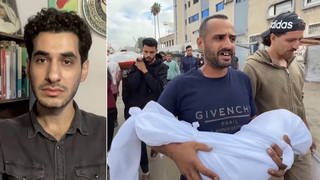
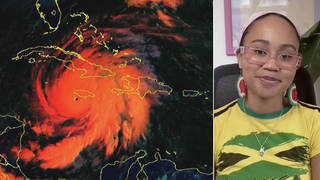
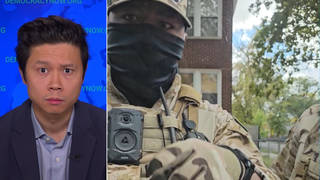






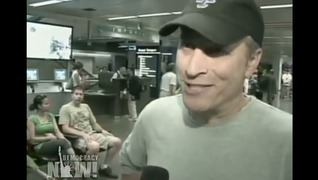
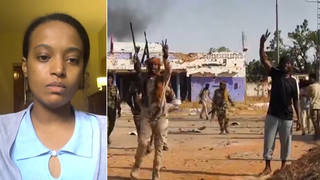
Media Options